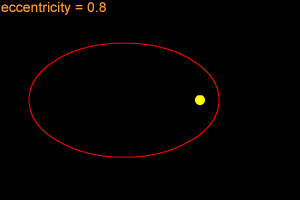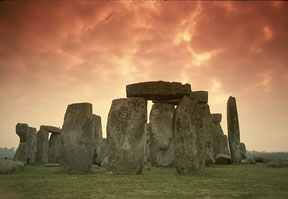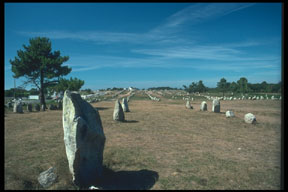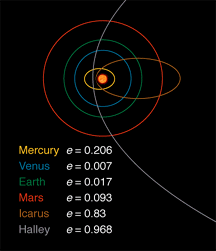A diagram showing the elliptical orbits of some solar system objects.
Click on image for full size
Kepler's 1st Law: Orbits are Elliptical
With Tycho Brahe's observations in hand, Kepler set out to determine
if the paths of the planets against the background stars could be
described with a curve. By trial and error, he discovered that an
ellipse with the Sun at one focus could accurately describe the orbit
of a planet about the Sun.
Ellipses are described mainly by the length of their two axes. The
longest one is called the major axis, and the short one is the minor
axis. The ratio of these two lengths determines the
eccentricity (e) of the ellipse; it's a measure of
how elliptical it is. Circles have e=0, and very stretched-out
ellipses have an eccentricity nearly equal to 1.
It's important to note that planets, while they do move on ellipses,
have nearly circular orbits. Comets are a good example of objects in
our solar system that may have very elliptical orbits. Compare the
eccentricities of the objects in the diagram.
Once Kepler figured out that planets move around the Sun on
ellipses, he then discovered another interesting fact about
the speeds of planets as they go around
the Sun.
You might also be interested in:

Kepler's second law he again discovered by trial and error. After some experimentation, Kepler realized that the line connecting the planet and the Sun sweeps out equal area in equal time. Look at the
...more
When one object is in orbit around another object, the orbit is usually an elliptical orbit. For example, all of the planets in our Solar System move around the Sun in elliptical orbits. An ellipse is
...more
Astronomers have announced the discovery of a large new planetoid named Sedna. Mike Brown of the California Institute of Technology, Chad Trujillo of the Gemini Observatory in Hawaii, and David Rabinowitz
...more
By 30,000 B.C,. Asian hunter-gatherers had crossed the Bering Strait into North America. These people were the first to inhabit this new land and so they are known as the Native Americans of North America.
...more
"The movements of the heavenly bodies are an admirable thing, well known and manifest to all peoples. There are no people, no matter how barbaric and primitive, that do not raise up their eyes, take note,
...more
The stones of Carnac, France, are probably the most famous stones markings outside of those found at Stonehenge in England. Where Stonehenge is composed of standing stones, the Carnac area has many different
...more
Not too far from Loch Ness, where the green highlands of Scotland rise and fall there lies three giant cairns of stones. They are called the Balnuaran of Clava. The Balnuaran of Clava, giant tombs encased
...more















